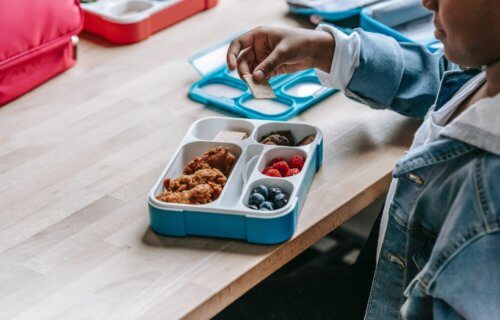URBANA, Ill. — Apples, broccoli, and carrots may not exactly be the first menu items on young students’ minds when they sit down for lunch each school day, but a new study suggests a novel way to encourage healthier eating among today’s youth. Researchers at the University of Illinois report extending lunch time makes kids more likely to eat fruits and vegetables.
“Ten minutes of seated lunch time or less is quite common. Scheduled lunch time may be longer, but students have to wait in line to get their food. And sometimes lunch periods are shared with recess. This means the amount of time children actually have to eat their meals is much less than the scheduled time,” says Melissa Pflugh Prescott, assistant professor in the Department of Food Science and Human Nutrition, in a university release.
The research team compared both fruit and vegetable consumption among students during 10 and 20-minute seated lunch sessions; finding the results leave little room for doubt.
“During shorter lunch periods, children ate significantly less of the fruit and vegetable parts of their meal, while there was no significant difference in the amount of beverages or entrees they consumed. It makes sense that you might eat the part of the meal you look forward to first, and if there’s enough time left you might go towards the other parts. But if there’s not enough time those items suffer, and they tend to be fruits and vegetables,” Prof. Prescott explains.
Importantly, study authors note these findings are particularly relevant for students from low-income families who may not have the means to bring their own lunch to school each day and then have to wait on long lines to get their meal.
More time at lunch is especially good for fruit consumption
Elementary- and middle school-aged children enrolled in a summer camp on the University of Illinois campus took part in this project. Study authors set up the campus lunch area like a normal school cafeteria and students had to form a line to pick out their food. The meals followed the preparation guidelines of the National School Lunch Program.
“We tried to make this as comparable to everyday school as possible. We worked with the local school district and used the same food distributors as they did, and we selected the menu items based on the local public school menu,” Prof. Prescott comments.
On a random basis, the team designated some days as “long lunch” days while others were “short lunch” afternoons. However, a long lunch followed every each short lunch with the exact same menu. Researchers did so to eliminate the possibility that different menus would lead to different nutritional choices.
The team also took pictures of each child’s tray as they exited the lunch line and monitored the kids as they ate to look out for any food sharing, interactions with peers, and phone use. Then, after finishing, each child placed their tray on a rack and filled out a two-question survey inquiring about the taste and appearance of their meal.
Overall, the children chose to eat more fruits than vegetables. However, general consumption of both fruits and vegetables increased considerably during longer lunch sessions.
Kids also build social skills at lunch
“In my opinion, one of the best things about the new nutrition standards (2010’s Healthy Hunger-Free Kids Act) is that they require a variety of vegetables be served each week, to ensure children from all income and resource levels get exposed to different healthy foods they might not have access to at home. But if we have lunch periods that are too short to allow children the opportunity to get used to those foods, then we’re almost setting the policies up to fail,” Prof. Prescott says.
“A main takeaway from our study is that children need protected time to eat their fruits and vegetables. Our findings support policies that require at least 20 minutes of seated lunch time at school,” she adds.
A longer lunch period may offer additional benefits for students beyond healthier eating as well.
“The amount of seated time children have is also a really valuable time for them to connect with their peers; they might have limited opportunities to do so throughout the school day. We found significantly fewer social interactions during the 10-minute lunch times. That indicates other positive outcomes may come from longer lunch breaks as well,” Prof. Prescott concludes.
The study appears in the journal JAMA Network Open.
